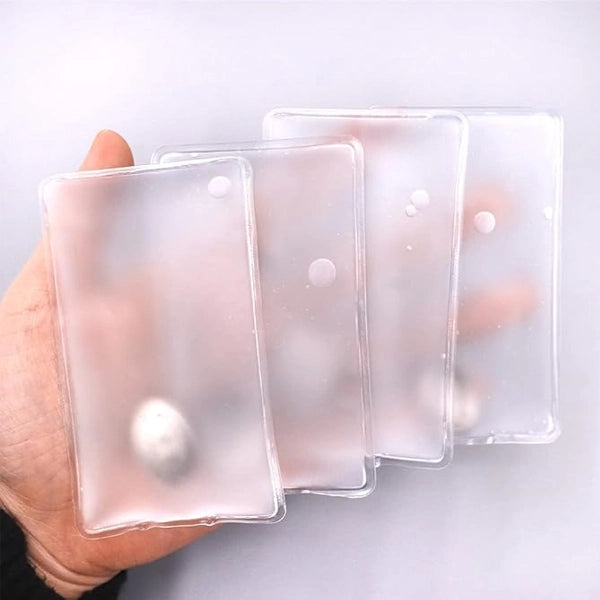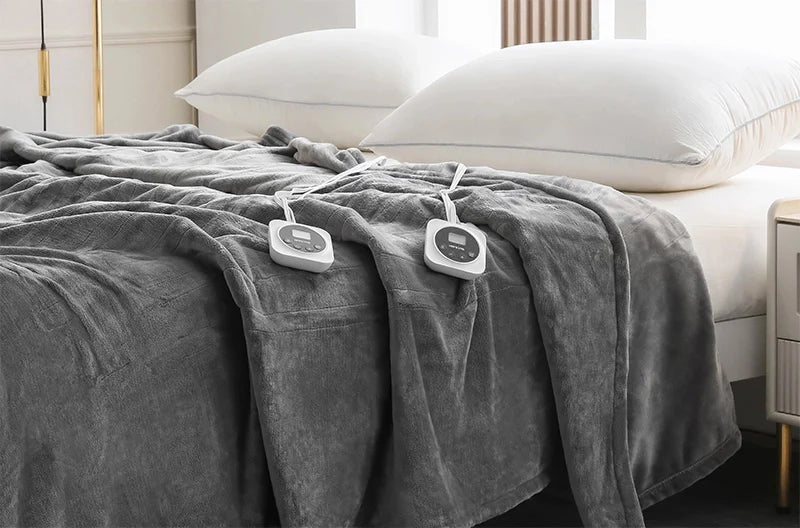What are the Different Types of Heating Pads?
Heat treatment is a well-liked and useful method for easing pain, menstrual cramps, muscle pain, and joint suffering. It gives pain relief, reduces stiffness in blood vessels, and improves blood flow.
The heating pad is the go-to item in your family health kit for everything from tender muscles after the first session of exercise to muscle pain from a past accident, unexpected joint discomfort on a wet day, menstrual cramps, or persistent back pain returning like an old friend.
Heating pads are a common tool for heat treatment, relieving pain and muscle pain, and they are available in microwaveable heating pads, electric heat packs, and infrared heating pads, which are some well-liked choices. Let's discuss the types of heating pads. A range of sorts, sizes, and forms. Electrical heat pads
How Many Types of Heating Pads are there?
There are several types of heating pads:
Electric Heating Pad
Winter is the peak season for demand for electric heating pads, which come with inbuilt coils. Electric heating pads are mostly used to relieve discomfort in the back and neck, and they normally have to be plugged into a power outlet to heat up. However, some electric heating pads may also be powered by batteries. Electric heating pads that run on batteries come with settings that allow you to adjust the temperature.
The usage of electric heating pads is rather easy. All you have to do is place it to the region that hurts. It not only lessens your discomfort but also maintains your body's warmth for an extended amount of time. Certain electrical heating pads are equipped with an automatic shut-off timer to prevent unexpected injury during use.

Infrared Heating Pad
Heat treatment is applied to sore regions using infrared heating pads, which transform electricity into infrared light and heat. Infrared heating pads feature higher temperatures and controls to adjust the heat.
Additionally, some include a timed option for an automated shut-off. Researchers have shown that infrared heating devices are an efficient way to get rid of persistent lower back discomfort. Infrared devices may be plug-in or need batteries.

Microwave Heating Pad
A microwave heating pad is a type of heating pad designed to be heated in a microwave oven. It typically consists of a fabric pouch filled with materials such as rice, flaxseed, or gel beads that retain heat when microwaved.
To use a microwave heating pad, you simply heat it in the microwave for a short period, following the manufacturer's instructions, and then place it on the desired area of the body for soothing warmth. These heating pads are often used for muscle relaxation, pain relief, or simply to stay warm during cold weather.

Source: https://youtu.be/94w1pkHtcGo
Chemical Heating Pad
Chemical heating pads are typically single-use and have a single exothermic chemical ingredient. A chemical reaction is required for these pads to produce momentary heat. You have to open an airtight packet containing wet iron power, which is mostly used for hand warming.
In addition, when they are exposed to air, they rust over a few hours. Certain chemical heating pads readily warm up when they come into contact with atmospheric oxygen. To release the heat, certain heating pads may need to be squeezed.

Gel or Liquid Heating Pad
Before the substance of a gel or liquid heating pad releases heat, it must be thoroughly heated. You may wear these thermal pads inside your garment to help warm the damaged region. Sodium acetate is the material that goes into these heating pads.
But before using them, it's essential to speak with a doctor or adhere to the manufacturer's recommendations. Heating pads made of liquid or gel are reusable; you may reheat them before using them again.

Advantages of Using Heating Pads
There are several advantages and benefits that come with owning a heating pad. Here is a list of all its benefits, ranging from financial to healthcare-related.
Alleviates Persistent Back Discomfort
Back discomfort is serious, and it may be quite debilitating when it persists. For the treatment of both acute and chronic back pain, heat therapy is advised. A heating device may eliminate your suffering since it can serve as your on-call, 24/7 personal physiotherapist for heat treatment at home.
Soothes Tense Muscles
Heat is the only thing that will really relieve your aching muscles, regardless of the cause. Heat is well recognized for its ability to ease pain and discomfort. Because it is portable and has a temperature that can be adjusted to suit an individual's needs, a heating pad may be used for the task.
Essential for Providing Elderly Care
Although the age of users of heating pads is irrelevant, those over 50 will benefit from this product to the greatest extent. There are various ways to generate heat, including using hot water bags, a sauna, or a hot bath.
Many people's bodily pain problems, whether related to their back or torso, may be resolved with a heating pad. It is important to monitor the temperature while using the heating pad, since elderly people may be more sensitive to it.
Improves Sleep Quality
It is very hard to sleep through discomfort and suffering, but using a heating pad on a daily basis helps your body relax and gives you better quality sleep. Heat aids in the speedier healing process by circulating nutrients and oxygen-rich blood to sore and fatigued muscles.
Less Expensive
While this doesn't directly improve your health, it does so indirectly by relieving the financial burden of paying for your physiotherapy appointments. Depending on the kind of pad you choose to buy, their prices may vary.
How do I Choose a Heating Pad?
When choosing a pad, consider the following factors to ensure it meets your needs:
Type of Heating Pad:
Decide between electric, infrared, or microwavable heating pads based on your preferences and the type of relief you seek.
Size and Shape:
Consider the area of your body you intend to treat and choose a pad size and shape that fits comfortably and covers the affected area adequately.
Temperature Settings:
Look for a heating pad with adjustable temperature settings so you can customize the heat level according to your comfort and needs. This is especially important if you have sensitive skin or require varying levels of heat for different conditions.
Safety Features:
Ensure the pad has safety features such as automatic shut-off timers to prevent overheating and burns, particularly if you plan to use it for extended periods or while sleeping.
Material and Comfort:
Opt for a pad made from soft, comfortable materials that are gentle on the skin and easy to clean. Some heating pads also feature extra padding or a soft cover for added comfort.
💡 Homlyns Tips:
Our weighted heating pad offers 10 adjustable heat levels to match your comfort. For safety, it includes an automatic shut-off feature. Made with advanced graphene technology and soft, breathable flannel, it provides even heat distribution and maximum comfort during use.
Do Heating Pads Use a Lot of Electricity?
The amount of electricity consumed by heating pads varies depending on factors such as the size of the pad, the temperature setting used, and the duration of use.
Generally, electric heating pads are designed to be energy-efficient, especially those with automatic shut-off timers that prevent them from running continuously.
While they do consume electricity, the usage is typically modest compared to other household appliances like refrigerators or air conditioners. Additionally, newer models often incorporate energy-saving features to minimize electricity consumption.
Infrared Heating Pad vs Regular Heating Pad
The main difference between infrared and regular heating pads lies in the way they produce heat and their penetration depth into the body.
Infrared heating pad works by emitting infrared waves, which penetrate deeper into the body's tissues, allowing infrared heat to reach muscles, joints, and even organs, providing more profound therapeutic effects such as increased blood circulation, pain relief, and tissue repair.
Regular heating pads, often referred to as electric heating pads, rely on conduction or convection to transfer heat to the body's surface. This type of heat tends to warm the skin and superficial tissues, providing temporary relief and relaxation.
What are the Different Types of Heat Therapy?
Thermotherapy refers to the therapeutic use of heat. There are several methods of thermotherapy, including:
Moist Heat Therapy:
This involves applying adjustable heat through sources like warm towels, warm baths, or moist heating pads. Moist heat penetrates deeper into tissues and can provide relief for sore muscles and stiffness.

Dry Heat Therapy:
Dry heat therapy includes adjustable heat pads, heat packs, or electric heating blankets. It's effective for targeting specific areas of pain or discomfort and can help relax muscles, provide pain relief, and alleviate tension, providing consistent heat.

Infrared Heat Therapy:
Infrared heat therapy uses heat intensity, consistent heat and special devices that emit infrared waves to penetrate deep into the body's tissues. This method promotes increased blood flow and pain relief, reduces inflammation, and provides relief for various types of pain, including muscle soreness and arthritis.
Hot Water Therapy:
Hot water therapy can be easily heated and involves immersing the body in warm water, such as in a hot tub or whirlpool bath, and retaining heat. It has main advantages and is an effective way to relax muscles at hot spots of body parts, improve circulation, relieve pain and instant relief from pain and stiffness in joints and muscles.

Paraffin Wax Therapy:
Paraffin wax therapy involves immersing the affected body part in warm paraffin wax. This method has numerous advantages. It helps to soothe joint pain, increase blood flow, reduce circulatory disorders and soften the skin.
Sauna Therapy:
Sauna therapy has several benefits. It involves exposing the body to the right temperature through a power source for a certain period in a sauna room. This method can promote relaxation at a desired level, detoxification through sweating, and relief from tension and soreness.

The Bottom Line!
There are three popular varieties of heating pads: electric, infrared, and microwaveable heat packs, all of which have pros and cons of their own.
Electric heat packs may last longer and are often more durable, but they also need an electrical connection to function and come with a greater risk of injuries or electrical shock.
Infrared heating pad emits infrared radiation to provide targeted warmth and pain relief. It penetrates deep into tissues to alleviate muscle tension, improve circulation, and promote healing.
While microwave heating pads are indeed lightweight and convenient for prolonged use, they may not retain heat as effectively as electric heating pads. Microwave heating pads rely on materials like rice or flaxseed, which can lose heat relatively quickly compared to the continuous heat provided by electric heating pads.
However, to choose the ideal heating pad, you must consider your unique requirements, tastes, and any safety concerns.
















Leave a comment